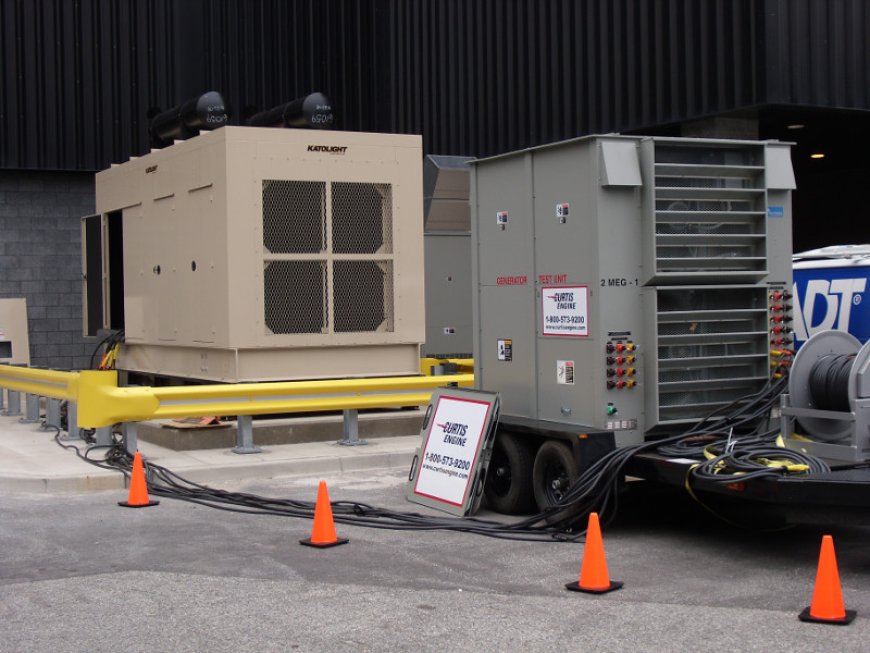Understanding Load Banks and Their Importance in Maintaining Power Systems
Generators are critical backup power sources that kick in automatically during a utility power failure. Regular resistance device testing verifies a generator can produce the rated kilowatts of power it is designed for under load.

Load banks are resistance devices that are used to apply an electrical load to generators, uninterruptable power supplies (UPS), and other backup power systems to test their operational capability and reliability. By applying a controlled electrical load, resistance devices allow operators to verify that these systems can deliver the power they are designed for under simulated load conditions. This pre-testing helps ensure backup power sources will operate as expected in the event of an outage.
Load Bank Testing is Important for Several Key Reasons:
Testing Generator Capacity
Generators are critical backup power sources that kick in automatically during a utility power failure. Regular resistance device testing verifies a generator can produce the rated kilowatts of power it is designed for under load. Applying different load percentages via a resistance device simulates real-world loading conditions to test full-load performance and response time. This confirms the generator has the capacity to handle critical site loads.
Exercising the System
Periodically exercising generator and backup power systems with a resistance device keeps these assets in working order. Much like exercising muscles, load testing helps identify any performance issues before an actual outage occurs. It exercises engine components, fuel systems, controls, and ensures all parts are functioning optimally and the system is ready for emergency duty.
Checking Fuel Consumption
Applying an electrical load reveals the generator's true fuel consumption characteristics under load. This is important information for facilities to budget operating costs accurately. Load testing also identifies any fuel delivery or usage issues that may impact runtime during an outage.
Monitoring Generator Parameters
Advanced resistance devices are equipped with monitoring capabilities that transmit real-time data on critical generator operating parameters like voltage, current, speed, and temperature to a control system. This allows operators to closely observe the generator's response to varying loads and identify any abnormal reactions or inefficiencies requiring service.
Types of Load Banks
There are different types of resistance devices used for testing stationary and mobile generator sets with various Load Bank capabilities:
Resistive Load Banks
The most common and basic type, resistive resistance devices work by passing electric current through resistor elements to create loading. They are compact, inexpensive to operate, and generate heat that needs to be rejected. Resistive resistance devices provide steady load but lack the ability for reactive loading.
Reactive Load Banks
These resistance devices have components like inductors and capacitors that provide both resistive and reactive loading. Reactive loading more accurately simulates the load characteristics a generator would see from motors and other non-linear loads in a real application. This type of comprehensive testing verifies volt-ampere output and power factor.
Low-frequency Resistance Devices
Special low-frequency resistance devices are needed to test very large generator sets used in utility-scale power plants. Their larger elements can safely dissipate megawatts of power at frequencies as low as 5-10 Hz.
Trailer-mounted Mobile Resistance Devices
For testing generator sets in the field, trailer-mounted resistance devices provide a compact, portable solution. Integrated cooling systems allow mobile resistance devices to apply high loads for exercising large generator sets at remote job sites or during maintenance outages.
Resistance Device Testing Procedure
Now that the basic types and purposes of resistance devices have been covered, let's examine the typical steps involved in properly conducting a resistance device test:
1. Ensure the generator is in good working condition with a full fuel tank prior to testing. Inspect all connections and control panels.
2. Position the resistance device a safe distance from the generator with adequate ventilation for heat rejection. Connect power cables to generator output leads according to resistance device manufacturer's instructions.
3. Start the generator set and allow a sufficient warm-up period for engine and electrical components.
4. Gradually apply incremental load levels from the resistance device control panel, typically in 25% steps, monitoring generator output parameters.
5. Test at full rated load capacity for 30 minutes or as recommended by manufacturer to fully exercise the system. Record all parameter data.
6. Vary the load up and down to check the generator can handle load changes smoothly without stalling or dropping frequency/voltage significantly outside acceptable ranges.
7. Gradually reduce the load to zero and let the generator run for several more minutes before shutting it down to cool internal components.
8. Document test results. Schedule required maintenance or repair based on any issues identified during testing.
9. Regularly repeat resistance device testing to certify the generator can reliably power critical equipment during outages as designed.
In conclusion, resistance device testing provides critical assurance that backup power systems such as emergency generators will operate trouble-free when needed most. By simulating real-world loading conditions, resistance devices enable operators to thoroughly exercise these systems, monitor performance, and catch minor problems before they escalate into major failures during power outages. When performed routinely according to manufacturer guidelines, resistance device testing is an essential maintenance task to ensure backup power reliability.
Get more insights on Load Banks
Get More Insights—Access the Report in the Language that Resonates with You
About Author:
Ravina Pandya, Content Writer, has a strong foothold in the market research industry. She specializes in writing well-researched articles from different industries, including food and beverages, information and technology, healthcare, chemical and materials, etc. (https://www.linkedin.com/in/ravina-pandya-1a3984191)












